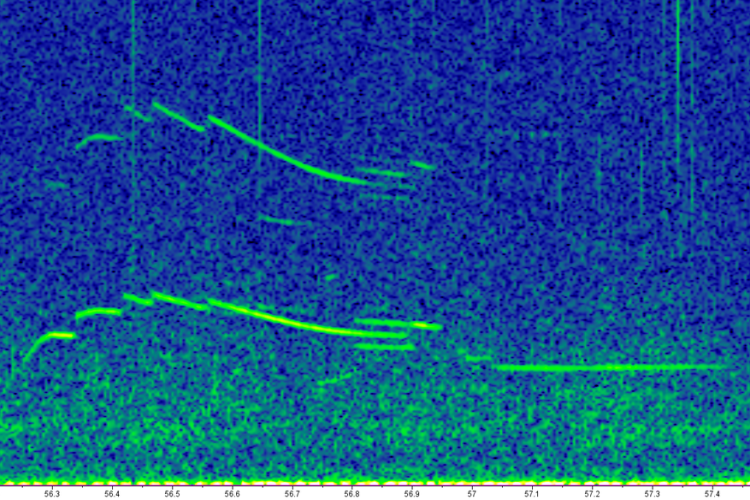At the Pacific Islands Fisheries Science Center, the Cetacean Research Program uses a variety of passive acoustic approaches to advance its assessment capabilities and to examine the relationships between cetaceans and their environment. The use of passive acoustics to gather critical data and to augment visual surveys is growing more important. Passive acoustic data are used to augment ship-based line-transect surveys, to help delineate cetacean populations, to assess occurrence and seasonality, and to estimate the density, abundance, and trends of cetacean populations within the Pacific Islands Region.
Passive Acoustics for Population Assessment
Whales and dolphins spend most of their time under the surface of the water, where visual monitoring methods are ineffective. Additionally, sound travels much farther in water than light, and cetaceans commonly use sound rather than vision to communicate with each other and to find food. Using passive acoustic tools, we can listen to the sounds made by whales and dolphins, their ambient environment, and any human-generated noise. These data augment our visual surveys for cetaceans and provide an opportunity to examine temporal and spatial changes in the density and behavior of some species at time scales that we can not monitor using other methods. The data also provide insight into the acoustic environment, the soundscape, and changes within that environment that might affect cetacean populations.
Our passive acoustics program incorporates a broad diversity of instrumentation- bottom-mounted long-term acoustic recording devices, miniature recorders for use on mobile or dynamic platforms, drifting medium-term acoustic recording devices, towed hydrophone arrays during ship-transect surveys, and many novel approaches to addressing our challenging mission. Passive acoustics is particularly well-suited to helping us understand three important elements of population assessment:
- Species occurrence and range: What species occur in the area, how are they distributed, and when are they there?
- Population abundance and trends: How many animals are in the population? How does that abundance change over time?
- Population stresses: What natural processes or human-caused threats may be impacting the population? Are threats constant or does the severity vary? Can the threat be reduced?
Instrumentation
Pacific Islands Passive Acoustic Network

HARPs are long-term acoustic recorders used to record a very broad frequency range, allowing us to hear more cetacean species. A HARP package is deployed at a specific location, then recovered after months to years to obtain its recorded data and identify the species detected by the HARP. Credit: NOAA Fisheries
The Pacific Islands Passive Acoustic Network (PIPAN) is designed to provide long-term monitoring of cetaceans in remote regions or areas of special interest. PIPAN sites are currently monitored using bottom-mounted passive acoustic data recorders called HARPs (high-frequency acoustic recording packages). HARPs are generally deployed at each site once or twice per year, recording sounds from 10 Hz to 100 kHz, and sometimes higher frequencies. They must be recovered to retrieve the data. The resulting data record includes vocalizations from both odontocetes and mysticetes, as well as ambient sounds (wind, rain, other organisms) and human-generated noises, such as echosounders, ships, and sonar.
To date, PIPAN includes recorders in 13 locations across the Pacific Islands region, including several that were deployed as early as 2006. We have them off the Kona coast of Hawaii Island (a 12-year record!), at Pearl and Hermes Atoll in the Northwestern Hawaiian Islands, at Wake Atoll, and off Saipan, Tinian, and Pagan in the Mariana Islands (see map). These long-term data sets allow us to assess the occurrence, seasonality, and long-term changes in distribution of species, as well as any changes in vocal behavior or distribution in response to increasing human sound sources or changing environmental conditions.

Towed Hydrophone Arrays
Passive acoustic tools also prove valuable in real-time applications. We conduct visual and acoustic cetacean surveys to estimate the distribution and abundance of each encountered species. During the survey, we use an acoustic array to listen for vocal cetaceans. The acoustic array consists of a series of hydrophones (underwater microphones) that we tow behind the ship (a "towed array") while it is moving along the survey trackline. The research team aboard the ship monitors the hydrophone signals with headphones and watches a visual representation of the sound—a spectrogram—for sounds that are at higher frequencies than can be detected by the human ear.
Using these techniques and a suite of processing software, the acoustic team can determine when a whale or dolphin is nearby, what species it is based on various characteristics of its vocalizations, and where it is relative to the ship. The location is estimated based on the geometry of the array itself—we can get a bearing to the vocal animal based on the difference in the time that a given sound is heard at each hydrophone (plus some trigonometry). A series of intersecting angles provided as the ship moves along the track provides a location. Acoustic detections provide an opportunity to collect additional data from the group and for some species, an opportunity to examine dive behavior and abundance based on information in the acoustic data.






